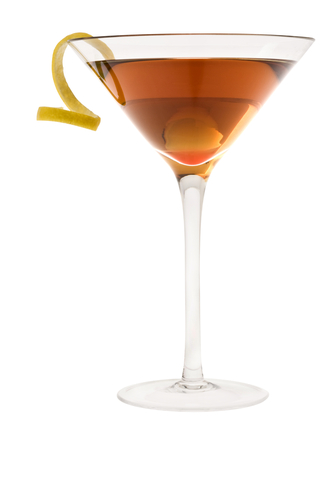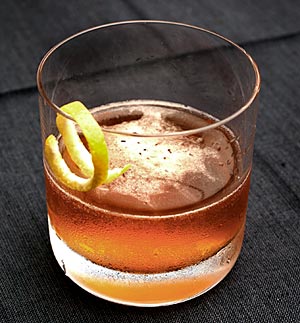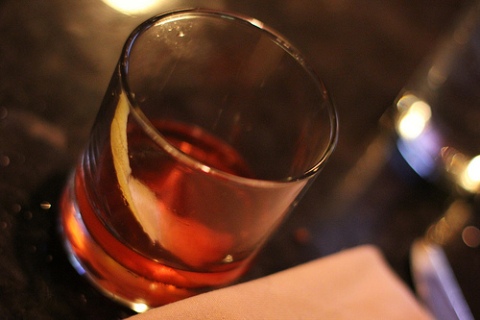Drink of the Week: The Suburban
 Today’s beverage serves a dual purpose. First, it continues my ongoing interest in classic cocktails featuring more than one variety of hard liquor. Secondly, it highlights the fact that you’re erstwhile cocktail explorer will very likely be soon be exchanging one not-quite-urban home base for another. Yes, if all goes as planned I’ll soon be leaving the vast quasi-suburban enclave that is Orange County, California only to very possibly move to the more centrally located, yet no less suburban, not-quite-city we call the San Fernando Valley — which is Los Angeles in the sense that you get to vote for the mayor of L.A.
Today’s beverage serves a dual purpose. First, it continues my ongoing interest in classic cocktails featuring more than one variety of hard liquor. Secondly, it highlights the fact that you’re erstwhile cocktail explorer will very likely be soon be exchanging one not-quite-urban home base for another. Yes, if all goes as planned I’ll soon be leaving the vast quasi-suburban enclave that is Orange County, California only to very possibly move to the more centrally located, yet no less suburban, not-quite-city we call the San Fernando Valley — which is Los Angeles in the sense that you get to vote for the mayor of L.A.
As for the Suburban cocktail, it’s a very relaxing but ultra-sophisticated drink that won’t be too all tastes. You might call it “urbane.”
The Suburban
1 1/2 ounces rye whiskey
1/2 ounce dark rum
1/2 ounce port
1 dash aromatic bitters
1 dash orange bitters
The ingredients might be unusual but the methodology is as routine as can be. Combine your various boozes and bitters in your cocktail shaker or mixing glass with plenty of ice. Purists will insist on stirring the concoction but I say shaking will also work. Strain into a chilled cocktail glass and drink a toast to Walt Disney, who envisioned fantastical wonderlands-cum-bedroom communities — most of which never came to be — in Orange County and elsewhere. (Uncle Walt’s company did finally build one planned community, Celebration, Florida, during the 1980s.)
***
For this drink, I used my go-to rye, 100 proof Rittenhouse. Some recipes call specifically for Jamaican Rum, but I used the very decent (and more reasonably priced) dark Whaler’s Rum from Hawaii because that’s what I had on hand. For the exact same reasons, I also used the inexpensive tawny port I’ve been using for a number of drinks lately.
As for the history of this beverage, which dates back to the early 20th century, it apparently has more to do with horse racing than civic sprawl. Even so, for now, the self-indulgent question remains, will Drink of the Week Central end up in one of the bedroom communities of the San Fernando Valley, where my new day job is located, or will I be taking advantage of my beloved hometown’s growing subway system with a move to the vastly more cityish Hollywood/Silver Lake/Los Feliz/Koreatown axis, or will I split the difference and land in North Hollywood or Studio City?
All I can tell you is that, if suburbia be my destination, I’ll try to make it the laid back no-judgements utopian Never Never Land envisioned by Hal David and Burt Bacharach, who also sings, in his fashion, in the song below. Okay, that may be unlikely, but at cocktail hour there’s a little bit of Hasbrook Heights in every home. (The song actually starts at around 0:15.)
You can follow us on Twitter and Facebook for content updates. Also, sign up for our email list for weekly updates and check us out on Google+ as well.
Posted in: Food & Drink, Lifestyle, Vices
Tags: aromatic bitters, Burt Bacharach, Celebration Florida, cocktails, dark rum, Drink of the Week, Hal David, Happy Hour, Hasbrook Heights, jamaican rum, Los Angeles County, orange bitters, Orange County, port, Rittenhouse Rye, rye, rye whiskey, San Fernando Valley, The Saratoga, The Surburban, Walt Disney, Whaler's Rum

 It is time to correct an old oversight this Friday the 13th. It seems that way back on the second DOTW, in which I dealt with that sturdiest of
It is time to correct an old oversight this Friday the 13th. It seems that way back on the second DOTW, in which I dealt with that sturdiest of  There was a time when calling a drink a cognac sazerac would have been close to calling a certain sandwich a “beef hamburger.” However, New Orleans’s magnificent contribution to
There was a time when calling a drink a cognac sazerac would have been close to calling a certain sandwich a “beef hamburger.” However, New Orleans’s magnificent contribution to  It might seem a bit odd, but it was current MSNBC political goddess and past Air America star Rachel Maddow whose radio “cocktail moments” largely propelled your loyal scribe’s fledgling interest in
It might seem a bit odd, but it was current MSNBC political goddess and past Air America star Rachel Maddow whose radio “cocktail moments” largely propelled your loyal scribe’s fledgling interest in 








